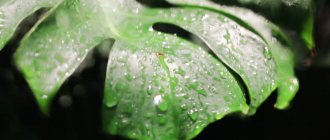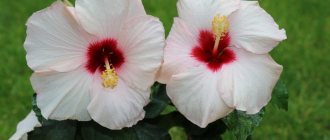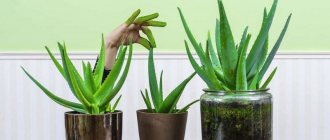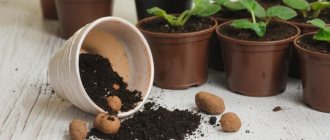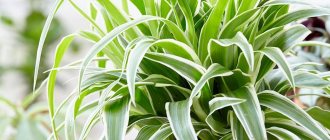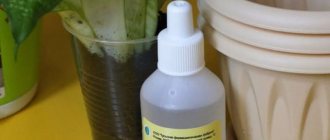Every first Ukrainian apartment or house has indoor plants. With rare exceptions. First of all, it's beautiful. And secondly, by the way, too. The beauty and visual appeal of indoor flowers is the main advantage of flora living in pots. But this is only at first glance. In fact, there is a more important plus: the ability of indoor plants to absorb negative energy and produce oxygen. We are sure that you have repeatedly heard that indoor plants purify the air in the room in which they grow. Today we want to talk about those domesticated representatives of the flora that produce oxygen not only in daylight, but also at night.
The list that you will find below will be useful to you if you want to organize your home or office space in a special way, filling it with plants that will actively work to purify the air. We are sure that you are familiar with most of the participants on this list. This means we don’t have to prove to you that these indoor green beauties are not only useful, but also incredibly beautiful.
Aloe vera
It would be strange if we named some other plant first, and not aloe vera. When our parents were young, aloe was in every home. Many people did not know then that this flower reproduces oxygen within 24 hours. However, they knew that aloe juice has a lot of useful properties, including valuable antiseptic properties. It was then and now used and continues to be used to treat many diseases. It is a good natural “medicine” for your home medicine cabinet and a popular ingredient in natural cosmetics and modern pharmaceuticals.
Among all the participants on our list, it is aloe vera that produces the greatest amount of oxygen at night. At the same time, the indoor flower is completely unpretentious. It does not require close attention from the grower and will not be offended even if you forget to water it several times in a row.
To get the maximum effect from growing aloe vera at home, experts recommend planting one plant in each room of your apartment or house.
Sansevieria
This indoor plant has many popular names. Sansevieria, which has a long leaf, is called “mother-in-law’s tongue” - because it is long. And knocked down compact bushes of sansevieria, which have short leaves, are often called “snake skin”. Apparently, for the variegated color, which the leaves are guaranteed to include different shades of green.
Today, pots of Sansevieria can often be found in the interior of catering establishments. If you don’t believe that this plant will decorate your home space, stop by your favorite restaurant and see for yourself. Just like aloe, Sansevieria is completely unpretentious. All it needs is watering. Water the soil as it dries out. Sansevieria does not need any other manipulations. She, of course, will be grateful to you for both spraying and feeding. But if you don’t waste time on this, the plant will understand your decision and will still produce oxygen 24 hours a day.
Azadirachta indica
This plant also has a shorter name - neem. People call this indoor flower a plant of purity. Firstly, due to the volume of oxygen produced. And secondly, thanks to the ability to purify not only the air, but also the atmosphere in the house. It is believed that neem actively processes negative energy and produces positive energy instead. And those who believe in such properties of indoor plants are sure that this is precisely the main and most valuable quality of Indian azadirachta.
An important advantage of azadirachta is that it acts on the air as a natural pesticide. This means that you don’t have to use “Raptor” in an apartment where there is a pot with this plant: midges, flies and mosquitoes will avoid it. That is, the plant will, in fact, create an invisible barrier between you and annoying insects.
In order for it to feel comfortable in your home and for it to efficiently perform all its stated functions, it is necessary to provide it with suitable soil and an abundance of sunlight.
Fine basil
Tulsi or fine-flowered basil not only sounds perfect in salads, soups and other dishes, but it also smells great. That is, flower growers will appreciate this beauty not only as an aromatic seasoning, but also as an air freshener in the house. Doctors say that the aroma of basil has a positive effect on the human nervous system: it calms, relieves stress, normalizes sleep, and even helps fight such severe and protracted painful conditions as depression.
It is best to place the tulsi pot in the room in which you relax. That is, in the living room or bedroom. If there are small children in the house, then fine basil can be planted on the windowsill in the nursery. They say that the plant has a beneficial effect on a baby's sleep and calms the baby during the period when he is attacked by colic or teething.
Geranium
When decorating the interior, you should not only take into account the beautiful appearance, but also pay attention to plants for purifying the air in the apartment. According to research by German scientists, the premises of modern people contain more than 1 thousand harmful substances. Of these, 250 are highly toxic and 50 are carcinogenic.
Houseplants are known to absorb carbon dioxide from the air and release oxygen.
Geranium, for example, releases essential oils, so it is recommended to place it in the bedroom, then you will not know what insomnia and depression are. In the morning you will wake up vigorous, ready to perform “feats”, and at night you will sleep like a baby. Remember that a houseplant absorbs oxygen at night, so you shouldn’t have a lot of flowers in the bedroom.
Fragrant flowers release more phytoncides and, as a result, the air in the room is purified more seriously. Geranium literally makes the air sterile, killing all types of harmful microorganisms, saturating the air with ozone. Staphylococci and streptococci are no exception. The plant will relieve headaches of any nature.
Orchid
At home we most often keep phalaenopsis - orchids, which are popularly nicknamed “butterflies”. It turns out that they are not only very tenacious and can go without watering for a long time, but they are also very useful, as they are able to produce oxygen 24 hours a day - without breaks, weekends and holidays. It is believed that phalaenopsis produces the greatest amount of oxygen in the dark. From this point of view, you need to find a place for a pot (or pots - if there is more than one phalaenopsis) where you sleep.
There is a myth that orchids are extremely whimsical plants. In reality, everything is exactly the opposite. Phalaenopsis does not require any attention from the grower at all - not at all. All it needs is at least more or less regular watering, as well as an abundance of sunlight.
Aglaonema
An easy-to-care flower with variegated leaves. It grows even in low light conditions, but loves moist air and plenty of water.
At home it can bloom and bear fruit, but Aglaonema berries are poisonous.
Effectively purifies the air from toluene and benzene, filters out most of the toxins contained in the air.
Can be kept in the living room, bedroom, hallway.
Orange gerbera
Gerbera, which decorates the house both at the time of flowering and at the moment of rest, is also a multifunctional indoor plant. It is logical that if it is present on this list, then its capabilities are not limited only to the round-the-clock production of oxygen (although, you see, this is already more than enough). It is believed that the phytoncides that orange gerberas release into the air protect people from cancer. In addition, gerbera is able to absorb benzene, which is released by other objects and phenomena. And only a few among indoor flowers are capable of this.
Carbon dioxide , which a person exhales in the process of life, is absorbed by the orange gerbera. Instead, the flower produces pure oxygen. The presence of a plant in the house has a beneficial effect on the state of the nervous system of all household members. Many noted that with the appearance of gerberas in the house they became calmer, stopped getting nervous over trifles, began to fall asleep better and sleep more soundly.
Spiderling (Chlorophytum)
The long, arching leaves of Chlorophytum look beautiful in a pot.
The main merit of chlorophytum is that the plant copes well with cigarette smoke and harmful components that enter the air when smoking.
Chlorophytum also purifies the air from benzene and formaldehyde, which are present in rubber and products of the printing industry.
This plant reproduces very easily, producing whip-like shoots. They can be shared with friends or dropped off at the office.
Chlorophytum is unpretentious, even novice gardeners can handle caring for it.
Ficus benjamina
Several decades ago, ficus benjamina was an extremely unwelcome guest in the house. And there was no question of putting him in an apartment. And all because several “yellow” newspapers in the 90s dispelled the myth that, supposedly, the souls of the dead live in the leaves of this plant, and therefore, growing it in the house is strictly prohibited. It’s so good that you and I have learned to distinguish truth from fiction and, despite the total Soviet past, have learned to think logically. Now such beauties as Ficus Benjamin live in our apartments - they delight us with their presence and work for our benefit.
The fact that ficus is a powerful source of oxygen, we believe, is already clear. But you may not have heard that its leaves are actively used to treat diabetes. In addition, ficus benjamina leaf extract is an integral ingredient in anti-constipation medications. And you say, souls of the dead! What kind of souls are there if he heals the living?
Decembrist
The official name of this plant is Rozhdestvennik cactus. And the plant was popularly called the Decembrist because it blooms in December, on the eve of the New Year. And this is especially nice, because in winter there is so little color around. Decembrist, like several plants on the list before it, produces maximum oxygen at night, that is, when the grower and household members are resting. Therefore, the best place for it would be a window sill in the bedroom or in the nursery, where representatives of the younger generation sleep.
Kalanchoe
First of all, Kalanchoe is a very beautiful plant. Any interior in which this blooming beauty appears is instantly transformed. It is noteworthy that Kalanchoe flowers can be matched to the interior, creating a kind of harmony. The varietal varieties of this representative of the flora are limitless, so you can choose a soft yellow, snow-white, hot pink, lilac, or purple flower for your home. But besides this, Kalanchoe is also a very useful plant. It produces oxygen both day and night - and at an equally intense pace. But in order for the flower to feel comfortable, it needs to be allocated a sunny location and watered regularly, avoiding overflow and drought in the pot.
Peperomia obtufolia
Peperomia cleanses the air of harmful impurities and has antibacterial and antiviral effects by releasing phytoncides.
This plant requires minimal care - moderate watering, fertilizing, spraying, location in partial shade.
The cheerful appearance of the plant can be used in the design of various interiors to create bright accents. It is suitable for the kitchen, living room, bedroom, children's room.
Representatives of the palm family
All palm trees and palms that humans have managed to domesticate actively process carbon dioxide, and instead supply oxygen into the indoor atmosphere. This is why palm trees are so often found in clinics, offices, government agencies and other facilities that are visited by hundreds, and maybe even thousands of people every day.
Interestingly, palm trees do more than just produce oxygen. They release beneficial microelements into the air. They also moisturize it no worse than a household appliance. Members of the palm family do not need sunlight to grow. They feel great in shaded spaces.
English ivy (Common ivy)
English ivy is an evergreen creeping vine. There are dozens of varieties with varied shapes and colors of its glossy leaves. Ivies are hardy and effective at creating green walls.
English ivy is one of the champions among indoor plants in absorbing carbon dioxide. It also purifies the air from viruses and bacteria and absorbs allergens.
Ivy will do well in standard room temperature, indirect light or partial shade. It requires abundant watering, spraying and fertilizing once every 2 weeks.
Ivy can cover the walls of residential and office premises of any size and purpose.

